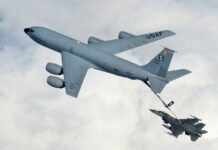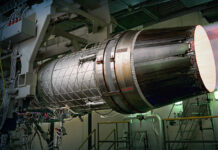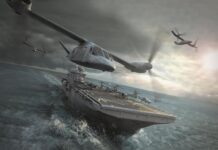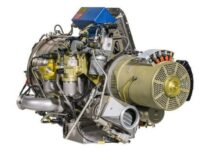While conventional fixed-wing aircraft and traditional helicopters continue to dominate military aviation, VTOL and tiltrotor aircraft are becoming increasingly interesting for both mainstream and niche applications.
Although helicopters or ‘rotary-lift’ aircraft take off and land vertically, the term Vertical Take-Off and Landing (VTOL) is generally not applied to them. A rotary-lift aircraft’s propulsion system centres around one or more fixed vertical masts topped by horizontally-aligned rotors. To transition from vertical to horizontal flight, the rotor disk is pitched slightly forward, but continues to rotate around the mast’s central axis with the main thrust directed downward. By contrast, VTOL refers to aircraft which produce vertical thrust for take-off and landing and are capable of hovering, but which transition to horizontal thrust for flight operations. Some aircraft are also defined as Short/Vertical Take-Off and Landing (S/VTOL) when the standard operating procedure calls for a short rolling take-off – often utilising a ski-ramp style aid – and a vertical landing. Usually such aircraft will be capable of a fully vertical take-off when necessary, albeit with a reduced payload.
The primary advantage of VTOL aircraft lies in their flexibility. They operate independent of runways and can take-off/land from relatively confined spaces, including parking lots, clearings, ship decks, and unprepared terrain. High-end VTOL which have been designed for purely military applications have comparable payload capacity, speed and mission-range as conventional take-off aircraft, and generally exceed helicopters in all of these parameters. On the other hand, numerous experimental and developmental VTOL aircraft currently being devised for civilian or dual-use applications have yet to outperform dedicated military helicopters.

Credit: USMC
There are numerous technical options for the design of VTOL fuselages and for the number and arrangement of propulsion units. Aircraft can be manned, optionally manned or unmanned. The fuselage design can mimic a conventional fixed-wing aircraft, resemble a helicopter, or be completely unconventional. Propulsion options include multiple rotors, propellers, fans or jets, which can be distributed along the wings or embedded in the fuselage. Vertical lift can be achieved in multiple ways, including fixed rotors, dedicated lift fans (in addition to the primary propulsion system), rotating fans, ducted fans, tiltrotors or tilting wings. Three options currently exist for the actual propulsion system: traditional aviation fuel-powered engines, electric propulsion, and hybrid systems using both. Electric and hybrid systems, known as eVTOL, are particularly popular for civilian applications.
These are frequently conceived as ‘air taxis’ for urban environments, which makes the low-decibel and environmentally friendly propulsion the system of choice. However, certain military and security applications – such as special operations insertion, SWAT transport, or even assault carrier – could also benefit from a quieter and stealthier approach capability.
There are many civilian VTOL (and especially eVTOL) development programmes underway in North America, Europe and Asia. Regarding military developments, the vast majority are being conducted in the United States.
VTOL Combat Aircraft
High-performance VTOL aircraft include the Harrier AV-8 and the F-35B Lightning II. The AV-8 achieves vertical lift through four rotating vectoring nozzles integrated into the flanks of the fuselage and which direct energy from the main propulsion system downward. The Harrier, which entered service in 1969, has been or is being retired by most operators. By contrast, the F-35B entered service in 2015, and constitutes the most modern and powerful VTOL-capable combat aircraft. The fifth-generation stealth aircraft’s characteristics include powerful long-range multi-spectral sensors, a potent electronic warfare (EW) suite, and the ability to carry a limited number of sophisticated air-to-air and air-to-ground weapons internally. It has the performance capabilities (450 NM (833 km) combat radius, Mach 1.6 airspeed, 6,800 kg weapons payload, and 7.0 g-rating) of conventional take-off and landing combat aircraft. Procurement by the US Marine Corps (USMC), the Italian Navy, the British Royal Navy and Royal Air Force, and the Republic of Singapore Air Force is ongoing.

Credit: US Navy/Spc. 1st Class Peter Burghart
The F-35B is technically an S/VTOL aircraft. When configured for a mission it requires a short runway or flight deck, optimally enhanced with a ski–ramp. However, a plane with minimal payload and a light fuel load can execute a fully vertical take-off, as demonstrated by Lockheed Martin on 10 May 2013. This capability permits relocating the aircraft to a different staging area. Once in the air, the plane – even when fully armed and fuelled – can hover in place or perform a vertical landing. The S/VTOL characteristics make this F-35 model ideal for deployment on amphibious warships and smaller to medium-sized aircraft carriers. The ability to operate from clearings and challenging landing zones will also enable Marines to establish roving refuelling and rearming points on islands or in coastal zones, enhancing operational flexibility and operational tempo.
The F-35B uses the same Pratt & Whitney F-135 engine as the conventional take-off F-35 variants. The Rolls-Royce designed VTOL system consists of three main components. The engine cowling opens to expose the lift fan which is mounted directly behind the cockpit and which directs 9,072 kgf (20,000 lbf) of thrust at a 90° angle to the fuselage. This downward thrust near the aircraft’s forward section is matched by another 8,165 kgf (18,000 lbf) of exhaust thrust directed downward by a 3 Bearing Swivel Module (3BSM) located at the engine’s rear. Together, the lift fan and the swivel duct divert the engine’s entire maximum thrust capacity into the vertical flight manoeuvre. These two components are augmented by two downward pointing ducts located at the root of each wing, which help stabilise the aircraft during vertical flight and together provide a further 885 kgf (1,950 lbf) of thrust. Once the pilot is ready to transition to horizontal flight mode, the engine cowling closes and the aft swivel duct returns to its normal position, a manoeuvre which can be completed within 2.5 seconds.
Tiltrotor Multi-mission Aircraft
Tiltrotors constitute a special category of VTOL aircraft. The engines are housed in nacelles located at the ends of a fixed wing. Rotors are mounted at the tip of the nacelles. Rotating shafts permit the nacelles to tilt by 90°, enabling the aircraft to take off and land vertically in ‘helicopter mode.’ Airborne, the nacelles rotate back to the horizontal position, permitting the aircraft to fly like a conventional turboprop. Tiltrotor technology thus combines the flexibility of the helicopter with the speed, range and fuel efficiency of conventional planes. These attributes make tiltrotors well-suited to a variety of military missions including general cargo and personnel transport, search and rescue, medical/casualty evacuation (medevac/casevac), special operations forces (SOF) transport, and assault carrier.
While military tiltrotor concepts were first introduced during World War II, the first successful operational aircraft is the medium-lift, multi-mission V-22 Osprey which entered service in 2007. The aircraft’s highly responsive engines can pivot by 90° within 12 seconds, supporting operations in high-intensity scenarios. Built by Boeing and Bell Helicopters, the Osprey comes in several variants, including: the USMC’s MV-22 optimised for airborne assault; the US Air Force (USAF) CV-22, equipped with extra fuel tanks, aerial refuelling capacity, and a special avionics and sensor package to support SOF missions; and the US Navy’s CVM-22 utilised for seaborne logistic support, with a range of 2,130 km (1,150 NM). The Japanese Self-Defence Forces received their first Ospreys in 2020, a portion of which will be deployed aboard the Izumo class aircraft carriers. The V-22 in all its variants is expected to serve through 2055.

Credit: USAF
In 2022, the US Army opted for the V-280 Valor tiltrotor for the service’s Future Long-Range Air Assault (FLRAA) aircraft. Built by Bell-Textron, the Valor externally resembles the larger Osprey, although it incorporates numerous enhancements and is considerably more agile. A V-shaped tail was chosen over the Osprey’s H-shaped tail to enhance manoeuvrability. The propulsion system has been simplified and employs pylon rotation rather than nacelle rotation; this promises to reduce heat development and simplify maintenance. It will be capable of transporting 12 combat-equipped soldiers. The 144 m/s (280 kn) airspeed and (configuration dependent) mission radius of 926-1,482 km (500–800 NM) offers twice the performance of today’s assault carrier helicopters, making it a viable platform even for conflicts in the Indo-Pacific region, where large distances between landmasses can be a major factor.
In addition to the combat role, the Valor will also perform utility/logistic support, medevac, and humanitarian/disaster relief missions. In 2018, Bell also proposed gunship variants of the V-280. The firm presented two different concept models. A purported Army variant showed air-to-ground missile racks extending from the passenger cabin. A maritime variant – suitable for either USMC or Navy applications (including anti-submarine warfare) – displayed greater modification, including a reduced radar cross-section, an internal weapons bay, and folding wings which would allow the aircraft to fit inside the hangar of a guided missile destroyer. While the services are currently not publicly contemplating a gunship version of the V-280, these concept displays demonstrate the versatility of tiltrotor technology.

Credit: US Army
Agility Prime
The United States Air Force is pursuing acquisition of small eVTOL systems. To this end, the service is evaluating civilian-developed or developmental ‘air taxi’ designs. The evaluation programme initiated in 2020 is called Agility Prime and is managed by AFWERX, a USAF technology incubator designed to support innovative development projects. The eVTOL concept is considered particularly suitable for urban military operations due to the reduced noise and heat signature. Such aircraft utilise smaller rotor systems than conventional helicopters, enhancing mobility and safety in urban terrain. Potential applications include Special Operations Forces (SOF) and urban assault, short-range cargo transport/battlefield resupply, search and rescue, medevac, installation security, and reconnaissance.
After reviewing 27 competing models, the Air Force selected seven for serious consideration in 2021. Since then the field has narrowed further. On 25 April 2023, the USAF and Joby Aviation announced a rapid acquisition contract award for up to nine of the firm’s S4 eVTOL aircraft. The S4 operates in tiltrotor mode to transition between vertical and horizontal flight. Four of the aircraft’s six electric motors are mounted on the wings, and two on the edges of the forward-swept V tail. Each rotor-equipped nacelle has an isolated battery pack to prevent a single point of failure preventing flight operations.
This is the first acquisition contract to be placed under the Agility Prime programme. The first two aircraft are to be delivered to Edwards Air Force Base by March 2024 for in-depth testing. The remaining aircraft could be evaluated at other military facilities; all service branches have expressed interest in eVTOL technology, with the USMC expressly planning to test the S4’s suitability for resupply, personnel transport, and emergency medical response applications. According to a USAF press release, testing at Edwards AFB will focus on the suitability for “short- to mid-range cargo operations at low operating costs and just-in-time delivery constructs.” USAF is also interested in the potential for transporting personnel between Edwards’ far-flung test ranges.

Credit: Joby Aviation
The optionally-manned S4 aircraft can carry up to five people (including a pilot) or a 450 kg payload. The aircraft’s proven 3,400 m service ceiling, 103 m/s (200 kn) maximum speed, and a stated range of 275 km – together with a 45 dB level in forward flight – would also favour SOF tactical operations should the military choose to utilise the aircraft beyond logistics missions. The Agility Prime programme office stresses that the S4 is not the sole aircraft of interest. The USAF plans to transition additional eVTOL systems into field-testing during 2023.
‘Next Generation’ High Speed VTOL
In addition to Agility Prime, AFWERX is also pursuing a High-Speed VTOL (HSVTOL) programme to meet a requirement by the US Special Operations Command (SOCOM). The goal is to acquire high-end, runway independent and air-refuellable aircraft capable of 400-kn flight speed to perform personnel infiltration, weapons and supply transport, tactical mobility and aeromedical evacuation. The target aircraft would eventually replace the CV-22 Osprey (which achieves 280 kn).
The initial call for ideas published in 2021 resulted in 218 proposals for aircraft and propulsion designs. In January 2022, the USAF selected 11 of these for Phase 1 contracts (concept development). The majority of the designs feature conventional turbine propulsion in order to achieve the required jet-like airspeed; a few include hybrid propulsion, but none are purely electric. Phase 1 ended on 30 June 2022. An indeterminate number of firms were to be carried over to the programme’s Phase 2 (risk reduction and design), followed by another down-select for Phase 3 (full-scale prototyping). The Request for Information (RFI) for Phase 2 was originally expected to be issued in autumn 2022, with work on this phase beginning in early 2023. The Air Force has not published additional information regarding the programme timeline, although AFWERX has previously stated an interest in accelerating HSVTOL development.

Credit: Bell Textron
Several firms have publicly presented information about their concepts. Jetoptera has patented the fluidic propulsion system (FPS) which utilises rotorless and bladeless fan technology. A small flow of compressed air is used to draw in ambient air which becomes disproportionally accelerated to provide thrust. The firm touts the system’s greater fuel efficiency and lower decibel levels when compared to conventional turbine systems, and its greatly improved speed and range versus electric propulsion. Jetoptera predicts a prototype could be ready for testing by 2025.
Bell, which has partnered with Pratt & Whitney for propulsion, has presented a family of tiltrotor aircraft with – in the company’s words – “the hover capability of a helicopter [and] the speed, range and survivability features of a fighter aircraft.” Vertical flight is accomplished via wingtip-mounted turboshaft nacelles topped by rotor blades. For forward flight, the nacelles rotate to the horizontal position and the rotors fold back for improved aerodynamics, while the aft-mounted primary engines provide high-speed turbofan propulsion. Bell has spoken of “emerging propulsion technologies” which could indicate plans to ultimately use a single convertible engine capable of alternating between turboshaft and turbofan modes for lift and cruise flight, respectively. Piasecki Aircraft Corporation entered the PA-1459 HSVTOL concept air vehicle into the competition. Graphics show two large aft-mounted turbofan engines equipped with vectoring thrusters, and two tilting ducted propellers amidship. The vectoring thrusters and the ducted propellers work together to provide full vertical thrust for take-off and landing. Another competitor, Valkyrie Systems Aerospace, is basing its proposal on the firm’s conceptual Guardian HoverJet, which is designed to achieve an airspeed of 201 m/s (390 kn) and a 15-hour mission endurance.

Credit: Piasecki Aircraft Corp.
These and the other proposals constitute what Col. Kenneth Kuebler, SOCOM’s Program Executive Officer for Fixed Wing Programs, has dubbed “the next generation of high-speed vertical take-off and landing.” While developing operational systems that meet the programme’s performance parameters is the ultimate goal, AFWERX has acknowledged that considerable technological challenges exist. The office’s self-proclaimed near-term goal is developing a conceptual framework that can assess realistic and optimal trade-offs between such factors as speed, range, payload, and mission spectrum.
Sidney E. Dean










